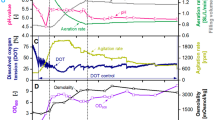Abstract
The heterolactic bacterium Oenococcus oeni ferments fructose by a mixed heterolactic/mannitol fermentation. For heterolactic fermentation of fructose, the phosphoketolase pathway is used. The excess NAD(P)H from the phosphoketolase pathway is reoxidized by fructose (yielding mannitol). It is shown here that, under conditions of C-limitation or decreased growth rates, fructose can be fermented by heterolactic fermentation yielding nearly stoichiometric amounts of lactate, ethanol and CO2. Quantitative evaluation of NAD(P)H-producing (phosphoketolase pathway) and -reoxidizing (ethanol, mannitol and erythritol pathways) reactions demonstrated that at high growth rates or in batch cultures the ethanol pathway does not have sufficient capacity for NAD(P)H reoxidation, requiring additional use of the mannitol pathway to maintain the growth rate. In addition, insufficient capacities to reoxidize NAD(P)H causes inhibition of growth, whereas increased NAD(P)H reoxidation by electron acceptors such as pyruvate increases the growth rate.



Similar content being viewed by others
References
Cavin JF, Prevost H, Lin J, Schmitt P, Divies C (1989) Medium for screening Leuconostoc oenos strains defective in malolactic fermentation. Appl Environ Microbiol 55:751–753
Dicks LM, Dellaglio F, Collins MD (1995) Proposal to reclassify Leuconostoc oenos as Oenococcus oeni [corrig.] gen. Nov., comb. Nov. Int J Syst Bacteriol 45:395–397
Garvie EI (1967) The growth factor and amino acid requirements of species of the genus Leuconostoc, including Leuconostoc paramesenteroides (sp. nov.) and Leuconostoc oenos. J Gen Microbiol 48:439–447
Kandler O (1983) Carbohydrate metabolism in lactic acid bacteria. Antonie van Leeuwenhoek 49:209–224
Maicas S, Ferrer S, Pardo I (2002) NAD(P)H regeneration is the key for heterolactic fermentation of hexoses in Oenococcus oeni. Microbiology 148:325–332
Nuraida L, Grigolava I, Owens JD, Campbell-Platt G (1992) Oxygen and pyruvate as external electron acceptors for Leuconostoc spp. J Appl Bacteriol 72:517–522
Richter H, Vlad D, Unden G (2001) Significance of pantothenate for glucose fermentation by Oenoccoccus oeni and for suppression of the erythritol and acetate production. Arch Microbiol 175:26–31
Salou P, Loubiere P, Pareilleux A (1994) Growth and energetics of Leuconostoc oenos during cometabolism of glucose with citrate or fructose. Appl Environ Microbiol 60:1459–1466
Veiga-Da-Cunha M, Firme P, San Romao MV, Santos H (1992) Application of [13C] nuclear magnetic resonance to elucidate the unexpected biosynthesis of erythritol by Leuconostoc oenos. Appl Environ Microbiol 58:2271–2279
Veiga-Da-Cunha M, Santos H, van Schaftingen E (1993) Pathway and regulation of erythritol formation in Leuconostoc oenos. J Bacteriol 175:3941–3948
Acknowledgements
The work was supported by grants from Innovationsstiftung Rheinland-Pfalz and the Fonds der Chemischen Industrie. We are grateful to Dr. A. De Graaf (Jülich) for helpful comments, and D. Vlad for expert support with many of the experiments.
Author information
Authors and Affiliations
Corresponding author
Rights and permissions
About this article
Cite this article
Richter, H., Hamann, I. & Unden, G. Use of the mannitol pathway in fructose fermentation of Oenococcus oeni due to limiting redox regeneration capacity of the ethanol pathway. Arch Microbiol 179, 227–233 (2003). https://doi.org/10.1007/s00203-003-0519-6
Received:
Revised:
Accepted:
Published:
Issue Date:
DOI: https://doi.org/10.1007/s00203-003-0519-6




